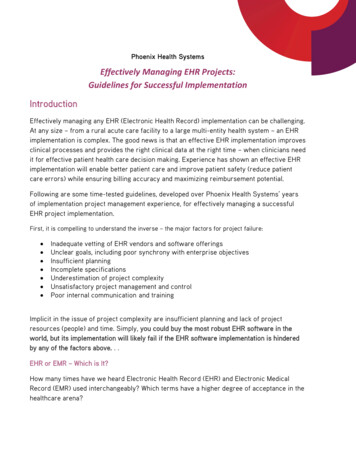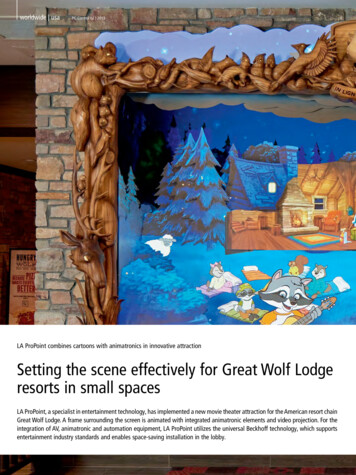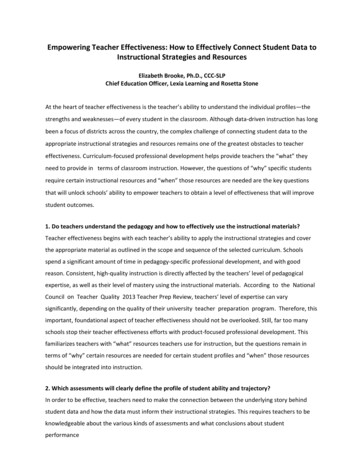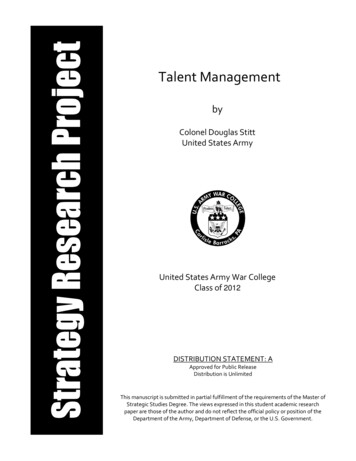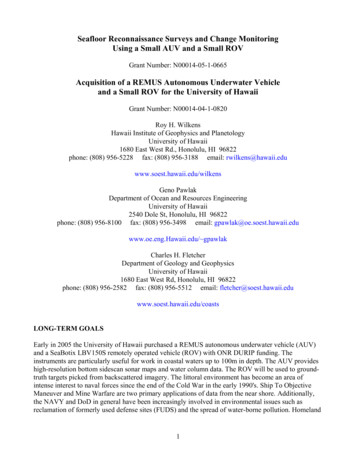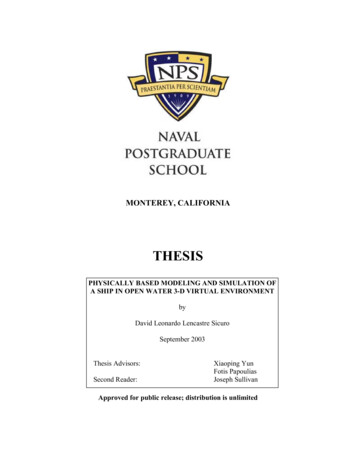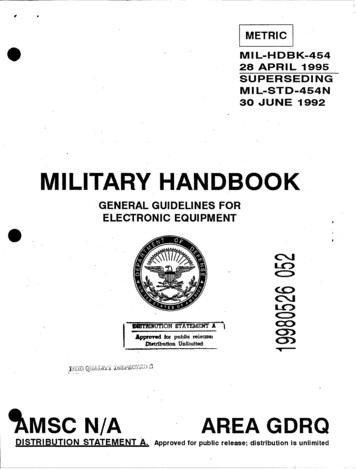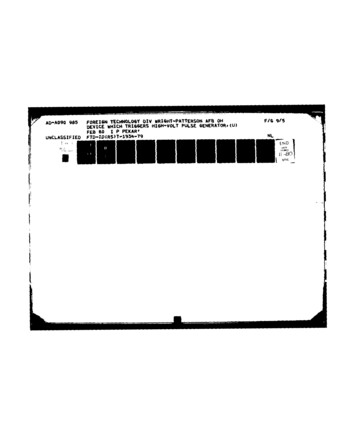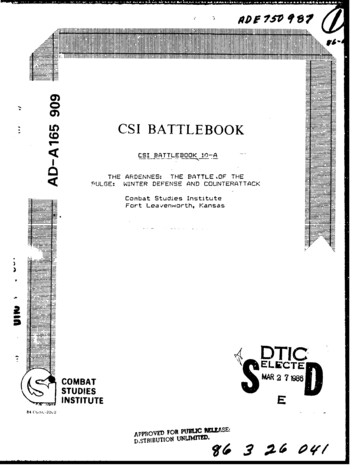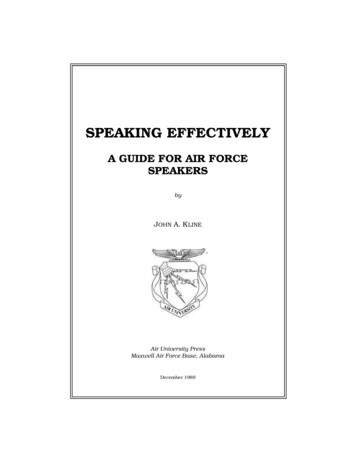
Transcription
SPEAKING EFFECTIVELYA GUIDE FOR AIR FORCESPEAKERSbyJOHN A. K LINEAir University PressMaxwell Air Force Base, AlabamaDecember 1989
Form ApprovedOMB No. 0704-0188Report Documentation PagePublic reporting burden for the collection of information is estimated to average 1 hour per response, including the time for reviewing instructions, searching existing data sources, gathering andmaintaining the data needed, and completing and reviewing the collection of information. Send comments regarding this burden estimate or any other aspect of this collection of information,including suggestions for reducing this burden, to Washington Headquarters Services, Directorate for Information Operations and Reports, 1215 Jefferson Davis Highway, Suite 1204, ArlingtonVA 22202-4302. Respondents should be aware that notwithstanding any other provision of law, no person shall be subject to a penalty for failing to comply with a collection of information if itdoes not display a currently valid OMB control number.1. REPORT DATE2. REPORT TYPEDEC 1989N/A3. DATES COVERED-4. TITLE AND SUBTITLE5a. CONTRACT NUMBERSpeaking Effectively: A Guide for Air Force Speakers5b. GRANT NUMBER5c. PROGRAM ELEMENT NUMBER6. AUTHOR(S)5d. PROJECT NUMBERJohn A. Kline5e. TASK NUMBER5f. WORK UNIT NUMBER7. PERFORMING ORGANIZATION NAME(S) AND ADDRESS(ES)8. PERFORMING ORGANIZATIONREPORT NUMBERAir Univ, Maxwell AFB, AL9. SPONSORING/MONITORING AGENCY NAME(S) AND ADDRESS(ES)10. SPONSOR/MONITOR’S ACRONYM(S)11. SPONSOR/MONITOR’S REPORTNUMBER(S)12. DISTRIBUTION/AVAILABILITY STATEMENTApproved for public release, distribution unlimited13. SUPPLEMENTARY NOTES14. ABSTRACT15. SUBJECT TERMSPublic speaking16. SECURITY CLASSIFICATION OF:a. REPORTb. ABSTRACTc. THIS PAGEunclassifiedunclassifiedunclassified17. LIMITATION OFABSTRACT18. NUMBEROF PAGESSAR8019a. NAME OFRESPONSIBLE PERSONStandard Form 298 (Rev. 8-98)Prescribed by ANSI Std Z39-18
Library of Congress Cataloging-in-Publication DataKline, John A.Speaking Effectively: A Guide for Air Force Speakers/by John A. Kline.p. cm.“December 1989.”1. Public speaking.I. Title.PN4121.K67 1989808.5’1 — dc2089-78063CIPFirst Printing January 1990Second Printing September 1990Third Printing June 1994Fourth Printing June 1995Fifth Printing June 1996DISCLAIMERThis publication was produced in the Department of Defense school environment in theinterest of academic freedom and the advancement of national defense-related concepts.The views expressed in this publication are those of the author and do not reflect the officialpolicy or position of the Department of Defense or the United States government.This publication has been reviewed by security and policy review authorities and is clearedfor public release.For Sale by the Superintendent of DocumentsUS Government Printing OfficeWashington, DC 20402ii
CONTENTSChapterPageDISCLAIMER . . . . . . . . . . . . . . . . . . . . . . . .iiFOREWORD . . . . . . . . . . . . . . . . . . . . . . .viiABOUT THE AUTHOR . . . . . . . . . . . . . . . . . .ixPREFACE . . . . . . . . . . . . . . . . . . . . . . . . .xi1PREPARING TO TALK . . . . . . . . . . . . . . . . . . . 1Types of Speaking . . . . . . . . . . . . . . . . . . . 2Briefing . . . . . . . . . . . . . . . . . . . . . 2Teaching Lecture . . . . . . . . . . . . . . . . . 2Speech . . . . . . . . . . . . . . . . . . . . . . 3Audience . . . . . . . . . . . . . . . . . . . . . . . 3Audience Analysis . . . . . . . . . . . . . . . . 4Audience Attitude . . . . . . . . . . . . . . . . 5Subject . . . . . . . . . . . . . . . . . . . . . . . . 6Selecting the Subject . . . . . . . . . . . . . . 6Narrowing the Subject . . . . . . . . . . . . . . 8Choosing a Title . . . . . . . . . . . . . . . . . 8Objectives . . . . . . . . . . . . . . . . . . . . . . . 9General Responses . . . . . . . . . . . . . . . . 9Specific Responses . . . . . . . . . . . . . . . . 9Gathering Material . . . . . . . . . . . . . . . . . 10Self . . . . . . . . . . . . . . . . . . . . . . .10Others . . . . . . . . . . . . . . . . . . . . . 11Library . . . . . . . . . . . . . . . . . . . . . 12Evaluating Material . . . . . . . . . . . . . . . . . 122ORGANIZING THE TALK . . . . . . . . . . . . . . . . .Time . . . . . . . . . . . . . . . . . . . . . . . . .Space . . . . . . . . . . . . . . . . . . . . . . . .Cause/Effect . . . . . . . . . . . . . . . . . . . .Problem/Solution . . . . . . . . . . . . . . . . . .Pro/Con . . . . . . . . . . . . . . . . . . . . . . .Topical . . . . . . . . . . . . . . . . . . . . . . .Combining Patterns . . . . . . . . . . . . . . . . .Now that You Have Organized . . . . . . . . . . .iii131415161718192022
ChapterPage3SUPPORTING THE TALK . . . . .Factors to Consider . . . . .Briefing . . . . . . . .Teaching Lecture . . . .Speech . . . . . . . . .Logical Thinking . . . . . .Slanted Reasoning . . .Irrational Appeals . . .Verbal Support . . . . . . .Definitions . . . . . . .Examples . . . . . . .Comparisons . . . . . .Testimony . . . . . . .Statistics . . . . . . . .Humor . . . . . . . . .Visual Support . . . . . . .Suggestions . . . . . .Using a Chalkboard . .After You Have Your Support. . . . . . . . . . . . . . . . . . . . . . . . . . . . . . . . . . . . . . . . . . . . . . . . . . . . . . . . . . . . . . . . . . . . . . . . . . . . . . . . . . . . . . . . . . . . . . . . . . . . . . . . . . . . . . . . . . . . . . . . . . . . . . . . . . . . . . . . . . . . . . . . . . . . . . . . . . . . . . . . . . . . . . . . . . . . . . . . . . . . . . . . . . . . . . . . . . . . . . . . . . . . . . . . . .232424242425252627272830313134363638384BEGINNING AND ENDING THE TALK . . . . . . . . . .Briefing . . . . . . . . . . . . . . . . . . . . . . .Introduction . . . . . . . . . . . . . . . . . .Conclusion . . . . . . . . . . . . . . . . . . .Teaching Lecture . . . . . . . . . . . . . . . . . .Introduction . . . . . . . . . . . . . . . . . .Conclusion . . . . . . . . . . . . . . . . . . .Speech . . . . . . . . . . . . . . . . . . . . . . .Introduction . . . . . . . . . . . . . . . . . .Conclusion . . . . . . . . . . . . . . . . . . .Suggestions for Gaining Attention . . . . . . . . .Question . . . . . . . . . . . . . . . . . . . .Quotation . . . . . . . . . . . . . . . . . . .Joke . . . . . . . . . . . . . . . . . . . . . .Startling Statement . . . . . . . . . . . . . .Gimmick . . . . . . . . . . . . . . . . . . . .Common Ground . . . . . . . . . . . . . . .Reference . . . . . . . . . . . . . . . . . . .Transitions and Interim Summaries . . . . . . . .Transitions . . . . . . . . . . . . . . . . . . .Interim Summaries . . . . . . . . . . . . . .After Preparation, Then What? . . . . . . . . . . .41414242424344454547484849505050515153535454iv
Chapter5PagePRESENTING A TALK . . . . . . . . . . . . . . . . . .Methods of Presentation . . . . . . . . . . . . . .Memorizing . . . . . . . . . . . . . . . . . .Manuscript Reading . . . . . . . . . . . . . .Impromptu . . . . . . . . . . . . . . . . . . .Extemporaneous . . . . . . . . . . . . . . . .Keyword Outline . . . . . . . . . . . . . . . .Nervousness . . . . . . . . . . . . . . . . . . . .Suggestions for Nervous Speakers . . . . . . .Physical Behavior . . . . . . . . . . . . . . . . . .Eye Contact . . . . . . . . . . . . . . . . . .Body Movement . . . . . . . . . . . . . . . .Gestures . . . . . . . . . . . . . . . . . . . .Use of Voice . . . . . . . . . . . . . . . . . . . . .Quality . . . . . . . . . . . . . . . . . . . . .Intelligibility . . . . . . . . . . . . . . . . . .Variety . . . . . . . . . . . . . . . . . . . . .Sincerity . . . . . . . . . . . . . . . . . . . . . . .v555556565959606364656566676869697071
FOREWORDDr Kline’s book, Speaking Effectively, is an essentialresource for anyone faced with any kind of speakingsituation. It contains hints, anecdotal examples, and theaccumulated wisdom of decades of speaking experience.John is highly regarded in government, religious, andcorporate circles and widely in demand because he is agreat speaker and because he can help anyone communicatemore effectively. He brings that expertise forward in a waythat both teaches and entertains.First published in 1989 and currently in its fourthprinting, Speaking Effectively teaches speakers throughoutthe Air Force and in other federal agencies the art ofcaptivating an audience. From preparation of your talkthrough delivery, this straightforward book takes youstep-by-step through the stages of effectively developingand presenting briefings, lectures, and speeches.This book includes such essential principles of effectivedelivery as speaking clearly, at the fight pace for youraudience and subject, and loud enough for all to hear, butnot too loud. Yet it also covers less obvious, but equallyessential, principles such as a speaker’s nonverbal signals,which can make or break a presentation.I strongly recommend Dr Kline’s book whether you are anovice or an experienced speaker. It will help the novicebegin developing time-proven speaking techniques, and itwill help more experienced speakers continue perfectingthe skills needed to grab and hold an audience.JAY W. KELLEYLieutenant General, USAFCommander, Air Universityvii
ABOUT THEAUTHORDr John A. KlineDr John A. Kline is a senior executive (SES) andAcademic Provost for Air University. He received his BSfrom Iowa State University. He held an NDEA Fellowshipwhile earning MS and PhD degrees at the University ofIowa.Dr Kline was professor of communication at theuniversities of New Mexico and Missouri–Columbia. He hasbeen at Air University since 1975 as professor, dean,educational advisor, and finally as provost.Dr Kline has written books, presented many papers, andpublished widely in leading professional journals. He is anaccomplished speaker, he has lectured extensivelythroughout the Air Force and he has presented manyspeeches to a variety of military, professional, religious,and corporate organizations worldwide.ix
PREFACESpeaking Effectively presents techniques on how tospeak successfully. It takes a “how-to” approach to effectivespeaking in the Air Force and presents proven techniquesas concisely and completely as possible. Experiencedspeakers will find little here that is new. Yet each speaker,no matter how skilled, needs to keep these basictechniques in mind.The content is organized chronologically according to thesteps a speaker would normally follow: preparing,organizing, choosing appropriate support material,deciding how to begin and end, and finally presenting theactual talk. Although these basic steps apply to any kind ofspeaking, some important variations exist to accommodatedifferent types of Air Force speaking. Therefore, the bookconsistently makes distinctions among the three types ofAir Force speaking: briefing, teaching lecture, and formalspeech.The book should not become a straightjacket to thinking.Nearly every principle, technique, and suggestion hasexceptions. In fact, the only principle that never changes isthat an effective speaker is always willing to adjust to theaudience. For this reason, the other principles can bemodified if the needs of the audience so dictate.Speaking Effectively is written for the officers, enlistedpersonnel, and civilians who must speak in the course ofperforming their day-to-day Air Force business. However,the principles and techniques do not apply only to AirForce speaking. They work in all situations, and they areas old as those in Aristotle’s Rhetoric or Cicero’s De Oratore.I am indebted to former teachers, students, andaudiences for the content of this book. I apologize if I haveused their ideas or those of other textbooks withoutacknowledging the source. Quite frankly, I haveassimilated these ideas into my own thinking and practice,and no longer know where I learned them.xi
Finally, I say a special thanks to my wife, Ann, whoendured my writing of this book. Even more, she has beenvery patient with a demanding traveling and speakingschedule that required not only time away but also time athome preparing speeches—time that I could have devotedto her.JOHN A. KLINExii
CHAPTER 1PREPARING TO TALKRecent studies show that speaking in front of a group is by farthe greatest fear of most people. It ranks ahead of the fear ofdying, riding in an airplane, or failure in other areas of one’spersonal life.Unless you are highly unusual, at some time in your life youhave talked to a group of people and your knees began shaking,your voice quivered, your head ached, and the only dry place onyour body was the inside of your mouth. Then the strange musclespasms began. One eyelid began to twitch uncontrollably. Your1
SPEAKING EFFECTIVELYlegs felt like soft rubber. And then it happened: Your memory, onits own and for no apparent reason, left you. At this point youpromised yourself that you would never get yourself in thissituation again.Although the fear of speaking is common, studies show thatone of the most admired qualities in others is their ability to speakin front of a group. Furthermore, other things being equal, theperson who can communicate ideas clearly will be moresuccessful. The remainder of this book is directed toward helpingyou be the kind of speaker others admire—the kind who gets thejob done in every speaking situation.Types of SpeakingThere are several types of speaking common in the Air Force.Although most of the same general principles and techniquesapply to all types, there are some differences.BriefingThe best military briefings are concise and factual. Their majorpurpose is to inform—tell about a mission, operation, or concept.At times they also direct—enable listeners to perform a procedureor carry out instructions. At other times they advocate orpersuade—support a certain solution and lead listeners to acceptthat solution. For example, a staff officer might want officers at ahigher echelon to accept a certain solution. Every good briefinghas the virtues of accuracy, brevity, and clarity. These are theABCs of the briefing. Accuracy and clarity characterize all goodspeaking, but brevity distinguishes the briefing from other typesof speaking. By definition, a briefing is brief, concise, and direct.Teaching LectureMuch speaking in the Air Force is directed toward teaching.2
PREPARING TO TALKThe lecture is the method of instruction most often used. As thename implies, the primary purpose of a teaching lecture is to teachor to inform students about a given subject. For convenience,teaching lectures can be divided into the following types: (1) formallectures, where the communication is generally one-sided with noverbal participation by the students, and (2) informal lectures,usually presented to smaller audiences and allowing for verbalinteraction between the instructor and students.SpeechA speech generally has one of three basic purposes: to inform,to persuade, or to entertain. The informative speech is a narrationconcerning a specific topic but does not involve a sustained effortto teach. Speeches to civic clubs, orientation talks, andpresentations at commanders’ calls are examples of speeches toinform. The persuasive speech is designed to move an audienceto belief or action on some topic, product, or other matter.Recruiting speeches to high school graduating classes, budgetdefenses, and courts-martial summations are all primarilyspeeches to persuade. The entertaining speech gives enjoymentto the audience. The speaker often relies on humor and vividlanguage as a primary means of entertaining the listeners. Aspeech at a dining-out may be a speech to entertain.AudienceTalking to hear one’s own voice may feed the ego and evencause self-persuasion, but whatever type of speaking you aredoing, the goal should be to communicate with others. A basicassumption, then, is that all speaking should be audiencecentered. Since speakers have a primary responsibility of adaptingthe message to the audiences, they need to know as much abouttheir audiences as possible.3
SPEAKING EFFECTIVELYAudience AnalysisThere are two reliable methods for gaining information aboutaudiences. Used together they can be extremely useful. The first isto organize information you already have about the audience.Knowing such variables as age, sex, rank, and experience canhelp you relate to the audience. If one or more of these or similarvariables separates you from the audience, you may want to givespecial attention to ways of emphasizing similarities and reducingdifferences.The second method, when you have not talked to a particulargroup before, is to check with someone who has. Perhaps a friend4
PREPARING TO TALKor colleague has already talked to the same group and can tell youwhat to expect. A local civic club regularly interrupts and hecklesguest speakers. Imagine the chagrin of a speaker who is notfamiliar with this practice and takes the interruption and hecklingpersonally. Granted, this audience behavior is a pretty extremecase and may not be the proper way for an audience to react. Still,it is better to know about such things before one speaks.Audience AttitudeIn the preceding instance, the uninforrned speaker mightassume wrongly that the audience was hostile. In some instances,you may have to face a hostile audience. An extreme example of aspeaker facing a hostile audience is when the President mustconfront a group of militants on the White House lawn. In suchcircumstances, the emotions of the audience are so great thateffective communication becomes very difficult.Most likely you will never have to speak to an overly hostileaudience, but you may have to speak to one that is mildly hostileeither to you or to your ideas. What can you do? Assuming thatyou are determined to be heard and the audience is willing to giveyou a chance, hostility can often be overcome. Clearly, your firsttask as a speaker is to change the audience attitude—if not tofriendliness, then at least to a more neutral position. Your chancesfor success are much greater if you somehow build rapport withyour listeners. Often this can be done by using one or more of thefollowing techniques:1. Avoid behaving in a conceited or antagonistic manner.2. Demonstrate a genuine concern for your listeners.3. Exhibit friendliness and warmth toward your listeners4. Emphasize similarities between your listeners and you.5. Be honest and straightforward.6. Use humor that is in good taste, especially if it is at yourown expense.5
SPEAKING EFFECTIVELY7. Indicate your association with people who are held in highesteem by the audience.8. Do not let negative, nonverbal aspects of your behaviorcontradict what you are saying.9. Demonstrate that you are an expert and have done yourhomework on the subject.10. Refrain from stating the main idea or conclusion at theoutset. Present your facts first that you and your listeners agreeupon, and then build toward your conclusion.Most audiences will be friendly. They consist of people whoare, for the most part, favorably disposed toward you as a speaker.Most people want you to do a good job. Furthermore, they usuallyare not in violent disagreement with your point of view. Aninformative briefing to other members of your organization, aspeech to a local civic club, and a teaching lecture in theclassroom are examples of speaking before friendly audiences.SubjectThe problem of selecting a subject for a briefing or teachinglecture does not often arise in the ordinary course of Air Forcebusiness. You will seldom have to look around for something totalk about. The subjects are implicit in the work of theorganization. A staff briefing, for example, arises from the need tocommunicate certain subject matter. A teaching lecture is given tosatisfy a particular curriculum need. On the other hand, a formalspeech to persuade, inform, or entertain may provide you withmore latitude in selecting the subject.Selecting the SubjectOn some occasions, the subject of your speech will bedetermined—at least partly—by the group. A local civic club, forinstance, may
corporate circles and widely in demand because he is a . the Air Force and in other federal agencies the art of captivating an audience. From preparation of your talk through delivery, this straightforward book takes you step-by-step through the stages of effectively developing . Air Force



